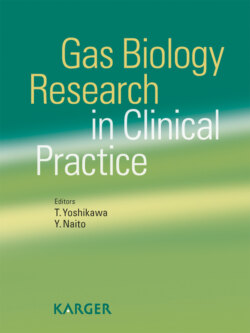Читать книгу Gas Biology Research in Clinical Practice - Группа авторов - Страница 34
На сайте Литреса книга снята с продажи.
Nitric Oxide
ОглавлениеNitric oxide (NO) is a colorless and poisonous gas which is generated by automobile and thermal power plants and causes a serious air pollutant. NO concentration in unpolluted air is approximately 0.01 parts per million (ppm). However, NO is an important signaling molecule in the body of mammals and was named ‘Molecule of the Year’ in 1992 [6]. NO plays an important role in vascular homeostasis by its potent vasoregulatory and immunomodulatory properties. Blood vessel dilation is one of the most well-known effects of NO. NO stimulates soluble guanylate cyclase (sGC) and increases cGMP content in vascular smooth muscle cells, resulting in relaxation of vascular tone and vasodilation. In addition to its vasorelaxant effect, NO has a complex spectrum of actions including the regulation of platelet activity and the preservation of the normal structure of the vessel wall. Thus, the actions of NO on blood vessels may increase tissue blood supply and abate the inflammatory response, leading to protection of the tissues from oxidative insults. Inhaled NO is already in clinical use for the treatment of hypoxic respiratory failure and pulmonary hypertension particularly in neonates and additional uses of NO are being investigated in other settings of lung and cardiac diseases [7]. Although multiple single-center studies demonstrated the ability of inhaled NO to improve the outcome of patients with adult ARDS were marginal [8], some studies advocate inhalation of NO as a method to prevent graft injury due to ischemia/reperfusion injury after human lung and liver transplantation.
